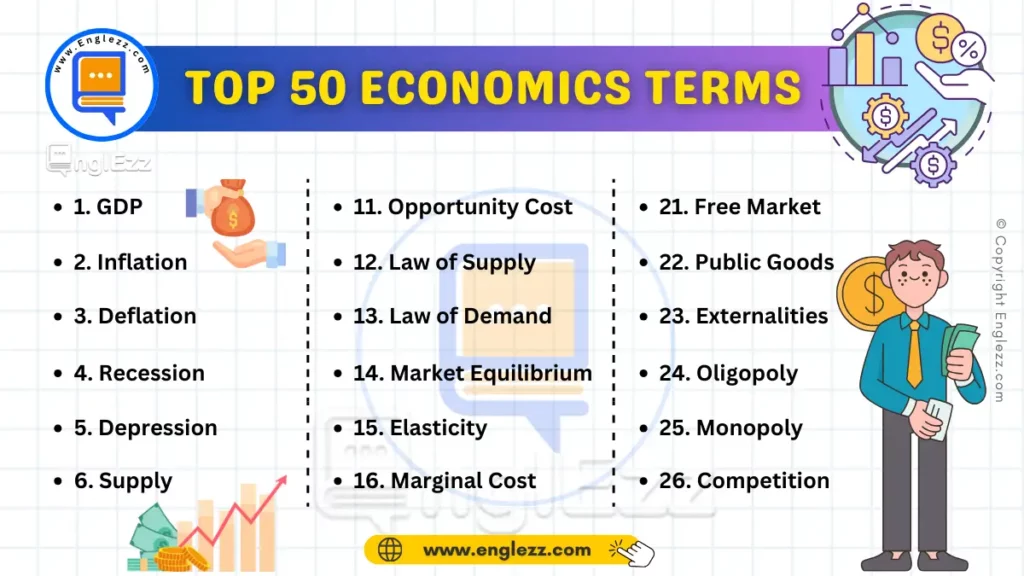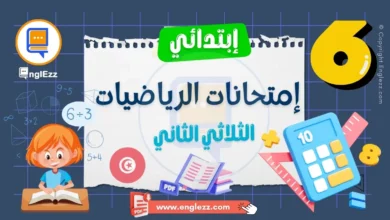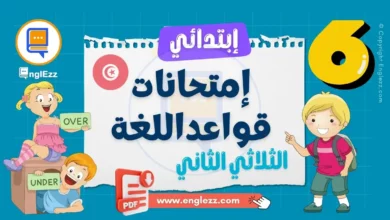Understanding economics is essential for navigating today’s globalized world. Whether you’re a student, professional, or just curious about how economies function, mastering key economics terms can empower you to engage in informed discussions and make better decisions. This post aims to introduce 50 fundamental economics English terms that are commonly used in both academic and practical settings.
Table of Contents
- Top 50 Economics English Terms Explained with Examples
- #1. 📉 Supply and Demand
- #2. 💹 Inflation
- #3. 💱 Exchange Rate
- #4. 📈 Gross Domestic Product (GDP)
- #5. 💵 Fiscal Policy
- #6. 📉 Recession
- #7. 📊 Monetary Policy
- #8. 💰 Interest Rate
- #9. 🏦 Central Bank
- #10. 📉 Deflation
- #11. 📊 Market Economy
- #12. 💹 Marginal Cost
- #13. 📉 Unemployment Rate
- #14. 💼 Capital
- #15. 💱 Exchange Rate Risk
- #16. 📉 Opportunity Cost
- #17. 📈 Price Elasticity
- #18. 📊 Consumer Price Index (CPI)
- #19. 💵 Deficit
- #20. 📉 Depression
- #21. 💸 Hyperinflation
- #22. 📈 Economic Growth
- #23. 🏦 Fiscal Stimulus
- #24. 📊 Keynesian Economics
- #25. 💹 Trade Surplus
- #26. 📉 Stagflation
- #27. 💼 Asset
- #28. 💱 Balance of Payments
- #29. 📈 Aggregate Demand
- #30. 📊 Aggregate Supply
- #31. 💹 Fiscal Policy
- #32. 📉 Monetary Policy
- #33. 💼 Gross National Product (GNP)
- #34. 📉 Supply-Side Economics
- #35. 💸 Capital Gain
- #36. 📊 Crowding Out
- #37. 📉 Current Account
- #38. 💵 Purchasing Power
- #39. 📈 Nominal Interest Rate
- #40. 📊 Real Interest Rate
- #41. 💹 Open Market Operations
- #42. 📉 Structural Unemployment
- #43. 💼 Inflationary Gap
- #44. 💱 Recessionary Gap
- #45. 📈 Velocity of Money
- #46. 📊 Comparative Advantage
- #47. 💹 Fiscal Deficit
- #48. 📉 Economies of Scale
- #49. 💼 Moral Hazard
- #50. 💸 Hyperinflation
- Economics English Terms Table
- Conclusion
Top 50 Economics English Terms Explained with Examples
Each term is accompanied by a clear definition, phonetic transcription, and examples to illustrate how the concept is applied in real-life scenarios. By familiarizing yourself with these terms, you’ll gain a stronger grasp of economic principles, enabling you to follow news stories, analyze financial reports, or even participate in policy debates with greater confidence.
From basic concepts like “supply and demand” to more complex ideas like “quantitative easing,” this guide provides a comprehensive overview that will enhance your economic literacy.
Read on to discover these essential economics terms and enrich your vocabulary, making you more conversant in the language of economics. Don’t forget to like and follow @EnglEzz for more valuable insights! 🌟
#1. 📉 Supply and Demand
Definition: The relationship between the quantity of a commodity that producers wish to sell at various prices and the quantity that consumers wish to buy.
Phonetic Transcription: /səˈplaɪ ənd dɪˈmænd/
Examples:
- Example 1: When the price of coffee decreases, the demand often increases due to more consumers wanting to buy it.
- Example 2: During a drought, the supply of crops may fall, leading to higher prices due to limited availability.
#2. 💹 Inflation
Definition: A general increase in prices and fall in the purchasing value of money.
Phonetic Transcription: /ɪnˈfleɪʃən/
Examples:
- Example 1: The annual inflation rate in the country reached 3%, meaning goods and services are more expensive than last year.
- Example 2: To curb inflation, the central bank raised interest rates.
#3. 💱 Exchange Rate
Definition: The value of one currency for the purpose of conversion to another.
Phonetic Transcription: /ɪksˈʧeɪnʤ reɪt/
Examples:
- Example 1: The exchange rate between the US dollar and the euro fluctuated due to economic instability.
- Example 2: Travelers often check the exchange rate before exchanging money for their trip.
#4. 📈 Gross Domestic Product (GDP)
Definition: The total value of goods produced and services provided in a country during one year.
Phonetic Transcription: /grəʊs dəˈmɛstɪk ˈprɒdʌkt/
Examples:
- Example 1: The GDP of the country increased by 2% last year, indicating economic growth.
- Example 2: A decrease in consumer spending can negatively impact a country’s GDP.
#5. 💵 Fiscal Policy
Definition: Government policies regarding taxation and spending to influence the economy.
Phonetic Transcription: /ˈfɪskəl ˈpɒlɪsi/
Examples:
- Example 1: The government implemented a fiscal policy to reduce the budget deficit by increasing taxes.
- Example 2: Expansionary fiscal policy was used to stimulate economic growth during the recession.

#6. 📉 Recession
Definition: A period of temporary economic decline during which trade and industrial activity are reduced.
Phonetic Transcription: /rɪˈsɛʃən/
Examples:
- Example 1: The country entered a recession after two consecutive quarters of negative GDP growth.
- Example 2: Unemployment rates typically rise during a recession.
#7. 📊 Monetary Policy
Definition: The process by which a central bank controls the supply of money, often targeting an inflation rate or interest rate to ensure stability and economic growth.
Phonetic Transcription: /ˈmɒnɪtəri ˈpɒlɪsi/
Examples:
- Example 1: The central bank implemented a monetary policy to reduce inflation by raising interest rates.
- Example 2: Expansionary monetary policy can help stimulate the economy by increasing the money supply.
#8. 💰 Interest Rate
Definition: The amount charged, expressed as a percentage of principal, by a lender to a borrower for the use of assets.
Phonetic Transcription: /ˈɪntrəst reɪt/
Examples:
- Example 1: A higher interest rate can discourage borrowing and reduce consumer spending.
- Example 2: The central bank lowered the interest rate to encourage investment and economic growth.
#9. 🏦 Central Bank
Definition: The national bank that provides financial and banking services for a country’s government and commercial banks and implements the government’s monetary policy.
Phonetic Transcription: /ˈsɛntrəl bæŋk/
Examples:
- Example 1: The central bank decided to increase interest rates to control inflation.
- Example 2: The central bank plays a crucial role in maintaining financial stability.
#10. 📉 Deflation
Definition: A decrease in the general price level of goods and services.
Phonetic Transcription: /dɪˈfleɪʃən/
Examples:
- Example 1: Deflation can lead to reduced consumer spending, which can further slow down the economy.
- Example 2: The country experienced deflation as prices fell and the economy contracted.
#11. 📊 Market Economy
Definition: An economic system in which production and prices are determined by unrestricted competition between privately owned businesses.
Phonetic Transcription: /ˈmɑːrkɪt ɪˈkɒnəmi/
Examples:
- Example 1: In a market economy, prices for goods and services are set by supply and demand.
- Example 2: The United States operates as a market economy with minimal government intervention.
#12. 💹 Marginal Cost
Definition: The cost added by producing one additional unit of a product or service.
Phonetic Transcription: /ˈmɑːrʤɪnəl kɒst/
Examples:
- Example 1: If a factory’s marginal cost of producing an additional widget is $5, producing more than one may lower the average cost.
- Example 2: Businesses use marginal cost to determine the optimal level of production.
#13. 📉 Unemployment Rate
Definition: The percentage of the total labor force that is unemployed but actively seeking employment.
Phonetic Transcription: /ʌnɪmˈplɔɪmənt reɪt/
Examples:
- Example 1: The unemployment rate increased to 7% during the economic downturn.
- Example 2: Economists monitor the unemployment rate to gauge economic health.
#14. 💼 Capital
Definition: Wealth in the form of money or other assets owned by a person or organization or available for a purpose such as starting a company or investing.
Phonetic Transcription: /ˈkæpɪtəl/
Examples:
- Example 1: A startup requires capital to purchase equipment and hire employees.
- Example 2: Investors provide capital in exchange for equity in a company.
#15. 💱 Exchange Rate Risk
Definition: The potential for an investor’s holdings to change in value due to fluctuations in currency exchange rates.
Phonetic Transcription: /ɪksˈʧeɪnʤ reɪt rɪsk/
Examples:
- Example 1: Companies that do business internationally must manage exchange rate risk to protect profits.
- Example 2: Investors in foreign stocks are exposed to exchange rate risk.
#16. 📉 Opportunity Cost
Definition: The loss of potential gain from other alternatives when one alternative is chosen.
Phonetic Transcription: /ˌɒpəˈtjuːnɪti kɒst/
Examples:
- Example 1: By choosing to invest in bonds instead of stocks, the opportunity cost is the potential higher return from stocks.
- Example 2: Time spent studying could have been used for leisure activities; this is an opportunity cost of education.
#17. 📈 Price Elasticity
Definition: A measure of how much the quantity demanded of a good responds to a change in the price of that good.
Phonetic Transcription: /praɪs ɪˌlæstɪˈsɪti/
Examples:
- Example 1: If the price of coffee increases, and demand drops significantly, coffee is said to have high price elasticity.
- Example 2: Necessities, like medication, often have low price elasticity because people will buy them regardless of price changes.
#18. 📊 Consumer Price Index (CPI)
Definition: A measure that examines the weighted average of prices of a basket of consumer goods and services, such as transportation, food, and medical care.
Phonetic Transcription: /kənˈsjuːmər praɪs ˈɪndɛks/
Examples:
- Example 1: The CPI rose by 2% last year, indicating an increase in the cost of living.
- Example 2: Governments use CPI to adjust social security payments to account for inflation.
#19. 💵 Deficit
Definition: The amount by which something, especially a sum of money, is too small.
Phonetic Transcription: /ˈdɛfɪsɪt/
Examples:
- Example 1: The country’s budget deficit widened as spending increased and revenue fell.
- Example 2: A trade deficit occurs when a country imports more goods than it exports.
#20. 📉 Depression
Definition: A severe and prolonged downturn in economic activity.
Phonetic Transcription: /dɪˈprɛʃən/
Examples:
- Example 1: The Great Depression of the 1930s was marked by a significant decline in industrial production and widespread unemployment.
- Example 2: Economic policies are designed to prevent a depression from occurring.
#21. 💸 Hyperinflation
Definition: Extremely rapid or out of control inflation.
Phonetic Transcription: /ˌhaɪpərɪnˈfleɪʃən/
Examples:
- Example 1: Hyperinflation in Zimbabwe led to prices doubling every day.
- Example 2: During hyperinflation, the currency can become worthless.
#22. 📈 Economic Growth
Definition: An increase in the amount of goods and services produced per head of the population over a period of time.
Phonetic Transcription: /ˌɛkəˈnɒmɪk ɡrəʊθ/
Examples:
- Example 1: Strong economic growth can lead to increased employment and higher living standards.
- Example 2: Technological advancements often spur economic growth.
#23. 🏦 Fiscal Stimulus
Definition: Increase in public spending or reduction in taxation designed to boost economic activity.
Phonetic Transcription: /ˈfɪskəl ˈstɪmjʊləs/
Examples:
- Example 1: The government implemented a fiscal stimulus package to combat the recession.
- Example 2: Tax cuts and increased government spending are common forms of fiscal stimulus.
#24. 📊 Keynesian Economics
Definition: An economic theory stating that government intervention is necessary to help economies emerge out of recession.
Phonetic Transcription: /ˈkeɪnziən ˌiːkəˈnɒmɪks/
Examples:
- Example 1: Keynesian economics suggests that government spending can stimulate demand and pull an economy out of recession.
- Example 2: During the Great Depression, Keynesian economics gained popularity as a way to revitalize struggling economies.
#25. 💹 Trade Surplus
Definition: The amount by which the value of a country’s exports exceeds the cost of its imports.
Phonetic Transcription: /treɪd ˈsɜːrpləs/
Examples:
- Example 1: A trade surplus can strengthen a country’s currency.
- Example 2: The country enjoyed a trade surplus due to high global demand for its goods.
#26. 📉 Stagflation
Definition: Persistent high inflation combined with high unemployment and stagnant demand in a country’s economy.
Phonetic Transcription: /stæɡˈfleɪʃən/
Examples:
- Example 1: The 1970s oil crisis led to stagflation in many Western economies.
- Example 2: Stagflation is challenging because traditional economic tools can’t combat both inflation and unemployment simultaneously.
#27. 💼 Asset
Definition: A resource with economic value that an individual, corporation, or country owns or controls with the expectation that it will provide future benefit.
Phonetic Transcription: /ˈæsɛt/
Examples:
- Example 1: Real estate is considered a valuable asset for most individuals.
- Example 2: Companies list their assets on their balance sheets.
#28. 💱 Balance of Payments
Definition: The difference in total value between payments into and out of a country over a period.
Phonetic Transcription: /ˈbæləns əv ˈpeɪmənts/
Examples:
- Example 1: A country with a balance of payments deficit may need to borrow money to pay its debts.
- Example 2: The balance of payments includes trade balance, foreign investments, and capital flows.
#29. 📈 Aggregate Demand
Definition: The total demand for goods and services within a particular market.
Phonetic Transcription: /ˈæɡrɪɡət dɪˈmænd/
Examples:
- Example 1: Economic policies can boost aggregate demand by increasing consumer spending.
- Example 2: High unemployment can reduce aggregate demand as fewer people have disposable income.
#30. 📊 Aggregate Supply
Definition: The total supply of goods and services available to a particular market from producers.
Phonetic Transcription: /ˈæɡrɪɡət səˈplaɪ/
Examples:
- Example 1: When aggregate supply exceeds aggregate demand, it can lead to deflation.
- Example 2: Aggregate supply can be influenced by labor costs, technology, and government policies.
#31. 💹 Fiscal Policy
Definition: The use of government revenue collection (taxation) and expenditure (spending) to influence the economy.
Phonetic Transcription: /ˈfɪskəl ˈpɒlɪsi/
Examples:
- Example 1: During a recession, governments might use fiscal policy to increase spending and reduce taxes to stimulate the economy.
- Example 2: Fiscal policy can also be used to curb inflation by reducing government spending.
#32. 📉 Monetary Policy
Definition: The process by which the monetary authority of a country, typically the central bank, controls the supply of money, often targeting an inflation rate or interest rate to ensure stability and economic growth.
Phonetic Transcription: /ˈmɒnɪtəri ˈpɒlɪsi/
Examples:
- Example 1: The central bank uses monetary policy to lower interest rates during a recession.
- Example 2: Tight monetary policy can be used to control inflation.
#33. 💼 Gross National Product (GNP)
Definition: The total value of all goods and services produced by a country’s residents over a specific time period, including income from abroad.
Phonetic Transcription: /ɡrəʊs ˈnæʃənəl ˈprɒdʌkt/
Examples:
- Example 1: GNP includes the value of all goods produced by citizens, whether within the country or abroad.
- Example 2: Economists use GNP to assess the economic performance of a country.
#34. 📉 Supply-Side Economics
Definition: A macroeconomic theory arguing that economic growth can be most effectively created by lowering taxes and decreasing regulation.
Phonetic Transcription: /səˈplaɪ saɪd ˌiːkəˈnɒmɪks/
Examples:
- Example 1: Supply-side economics suggests that lower taxes can lead to increased production and economic growth.
- Example 2: Critics of supply-side economics argue it disproportionately benefits the wealthy.
#35. 💸 Capital Gain
Definition: An increase in the value of a capital asset that gives it a higher worth than the purchase price.
Phonetic Transcription: /ˈkæpɪtəl ɡeɪn/
Examples:
- Example 1: Selling a stock for more than its purchase price results in a capital gain.
- Example 2: Capital gains can be subject to different tax rates depending on the holding period.
#36. 📊 Crowding Out
Definition: A situation in which increased public sector spending displaces or reduces private sector spending.
Phonetic Transcription: /ˌkraʊdɪŋ ˈaʊt/
Examples:
- Example 1: When the government borrows heavily, it can lead to crowding out by driving up interest rates.
- Example 2: Critics argue that excessive public sector spending can crowd out private investment.
#37. 📉 Current Account
Definition: A country’s trade balance, plus net income, and direct payments between it and other countries.
Phonetic Transcription: /ˈkʌrənt əˈkaʊnt/
Examples:
- Example 1: A surplus in the current account indicates a country exports more goods and services than it imports.
- Example 2: The current account includes trade in goods and services, as well as income from foreign investments.
#38. 💵 Purchasing Power
Definition: The value of a currency expressed in terms of the amount of goods or services that one unit of money can buy.
Phonetic Transcription: /ˈpɜːʧəsɪŋ ˈpaʊər/
Examples:
- Example 1: Inflation decreases the purchasing power of money, meaning you can buy less with the same amount.
- Example 2: Currency exchange rates affect the purchasing power of international tourists.
#39. 📈 Nominal Interest Rate
Definition: The interest rate before taking inflation into account.
Phonetic Transcription: /ˈnɒmɪnəl ˈɪntrɪst reɪt/
Examples:
- Example 1: A nominal interest rate of 5% does not consider the inflation rate, which could reduce real returns.
- Example 2: Nominal interest rates are often quoted by banks and financial institutions.
#40. 📊 Real Interest Rate
Definition: The interest rate that has been adjusted to remove the effects of inflation to reflect the real cost of funds to the borrower.
Phonetic Transcription: /riːl ˈɪntrɪst reɪt/
Examples:
- Example 1: If the nominal interest rate is 6% and inflation is 2%, the real interest rate is 4%.
- Example 2: Real interest rates provide a clearer picture of the cost of borrowing money.
#41. 💹 Open Market Operations
Definition: Activities by a central bank to buy or sell government bonds on the open market to regulate the money supply.
Phonetic Transcription: /ˈəʊpən ˈmɑːrkɪt ˌɒpəˈreɪʃənz/
Examples:
- Example 1: The central bank conducts open market operations to increase liquidity in the banking system.
- Example 2: By selling government bonds, the central bank can reduce the money supply.
#42. 📉 Structural Unemployment
Definition: Long-term unemployment that occurs when workers’ skills do not match the jobs available.
Phonetic Transcription: /ˈstrʌktʃərəl ʌnɪmˈplɔɪmənt/
Examples:
- Example 1: Advances in technology can lead to structural unemployment in certain industries.
- Example 2: Retraining programs can help reduce structural unemployment by equipping workers with new skills.
#43. 💼 Inflationary Gap
Definition: The amount by which actual GDP exceeds potential full-employment GDP.
Phonetic Transcription: /ɪnˈfleɪʃənəri ɡæp/
Examples:
- Example 1: An inflationary gap can occur when demand in an economy exceeds supply.
- Example 2: Policymakers may raise interest rates to close an inflationary gap.
#44. 💱 Recessionary Gap
Definition: A situation where the real GDP is lower than the potential GDP at the full employment level.
Phonetic Transcription: /rɪˈseʃənəri ɡæp/
Examples:
- Example 1: A recessionary gap indicates an economy is operating below its full potential.
- Example 2: Governments may use fiscal or monetary policies to close a recessionary gap.
#45. 📈 Velocity of Money
Definition: The rate at which money is exchanged in an economy. It is often used to measure the economy’s vitality.
Phonetic Transcription: /vɪˈlɒsɪti əv ˈmʌni/
Examples:
- Example 1: A high velocity of money suggests a high level of economic activity.
- Example 2: During a recession, the velocity of money tends to decrease as people save more.
#46. 📊 Comparative Advantage
Definition: The ability of a party to produce a particular good or service at a lower opportunity cost than others.
Phonetic Transcription: /kəmˈpærətɪv ədˈvɑːntɪʤ/
Examples:
- Example 1: A country has a comparative advantage in producing wine if it can produce wine at a lower opportunity cost than its trade partner.
- Example 2: Comparative advantage explains why countries engage in international trade.
#47. 💹 Fiscal Deficit
Definition: The difference when a government’s total expenditures exceed the revenue that it generates, excluding money from borrowings.
Phonetic Transcription: /ˈfɪskəl ˈdɛfɪsɪt/
Examples:
- Example 1: A high fiscal deficit can lead to increased borrowing and national debt.
- Example 2: Policymakers aim to reduce the fiscal deficit through spending cuts or tax increases.
#48. 📉 Economies of Scale
Definition: The cost advantages that enterprises obtain due to their scale of operation, with cost per unit of output generally decreasing with increasing scale.
Phonetic Transcription: /ɪˈkɒnəmiz əv skeɪl/
Examples:
- Example 1: Larger factories can produce goods more efficiently, benefiting from economies of scale.
- Example 2: Economies of scale can result in lower prices for consumers.
#49. 💼 Moral Hazard
Definition: When a party engages in risky behavior knowing that it is protected against the risk because another party will incur the cost.
Phonetic Transcription: /ˈmɒrəl ˈhæzəd/
Examples:
- Example 1: Bailouts during a financial crisis can create a moral hazard by encouraging risky behavior.
- Example 2: Insurance can lead to moral hazard if policyholders take on more risk than they would without coverage.
#50. 💸 Hyperinflation
Definition: Extremely high and typically accelerating inflation, often exceeding 50% per month.
Phonetic Transcription: /ˈhaɪpərɪnˈfleɪʃən/
Examples:
- Example 1: Hyperinflation in Zimbabwe led to the collapse of its currency in the late 2000s.
- Example 2: Hyperinflation can erode savings and devastate economies.
Economics English Terms Table
| 1. GDP | 11. Opportunity Cost | 21. Free Market |
| 2. Inflation | 12. Law of Supply | 22. Public Goods |
| 3. Deflation | 13. Law of Demand | 23. Externalities |
| 4. Recession | 14. Market Equilibrium | 24. Oligopoly |
| 5. Depression | 15. Elasticity | 25. Monopoly |
| 6. Supply | 16. Marginal Cost | 26. Competition |
| 7. Demand | 17. Marginal Revenue | 27. Consumer Surplus |
| 8. Unemployment | 18. Trade Balance | 28. Producer Surplus |
| 9. Interest Rate | 19. Exchange Rate | 29. Budget Deficit |
| 10. Fiscal Policy | 20. Monetary Policy | 30. Crowding Out |
| 31. Current Account | 41. Hyperinflation | 51. Liquidity |
| 32. Purchasing Power | 42. Fiscal Deficit | 52. Stagflation |
| 33. Real GDP | 43. Economies of Scale | 53. Opportunity Cost |
| 34. Nominal GDP | 44. Comparative Advantage | 54. Phillips Curve |
| 35. Aggregate Demand | 45. Moral Hazard | 55. Deadweight Loss |
| 36. Aggregate Supply | 46. Open Market Operations | 56. Velocity of Money |
| 37. Fiscal Policy | 47. Structural Unemployment | 57. Real Interest Rate |
| 38. Monetary Policy | 48. Inflationary Gap | 58. Nominal Interest Rate |
| 39. Gross National Product | 49. Recessionary Gap | 59. Supply-Side Economics |
| 40. Supply-Side Economics | 50. Crowding Out | 60. Capital Gain |
Conclusion
Understanding these 50 economics terms equips you with the foundational knowledge needed to engage in discussions about the economy, whether you’re analyzing financial reports, studying for exams, or simply trying to make sense of the economic news.
Each term has been selected for its relevance and importance in the field of economics, making this guide a valuable resource for anyone looking to improve their economic literacy.
By mastering these terms, you’ll be better prepared to navigate the complexities of the global economy, make informed decisions, and contribute meaningfully to economic debates.
Don’t forget to share this post with others who might find it helpful and follow @EnglEzz for more educational content! 🌟









Want to boost your economics vocabulary? 🌟 Dive into these essential terms and get a clearer understanding of the global economy. 📈✨Don’t forget to follow and like @EnglEzz for more insights! Visit for more. 💬
.
https://www.englezz.com/top-50-economics-english-terms/
.
#englezz #vocabulary #linguistics #economics #finance #learnenglish #business #economicsterms #financialliteracy #knowledge